ABS AUDI TT ROADSTER 2014 Owners Manual
[x] Cancel search | Manufacturer: AUDI, Model Year: 2014, Model line: TT ROADSTER, Model: AUDI TT ROADSTER 2014Pages: 244, PDF Size: 60.87 MB
Page 15 of 244
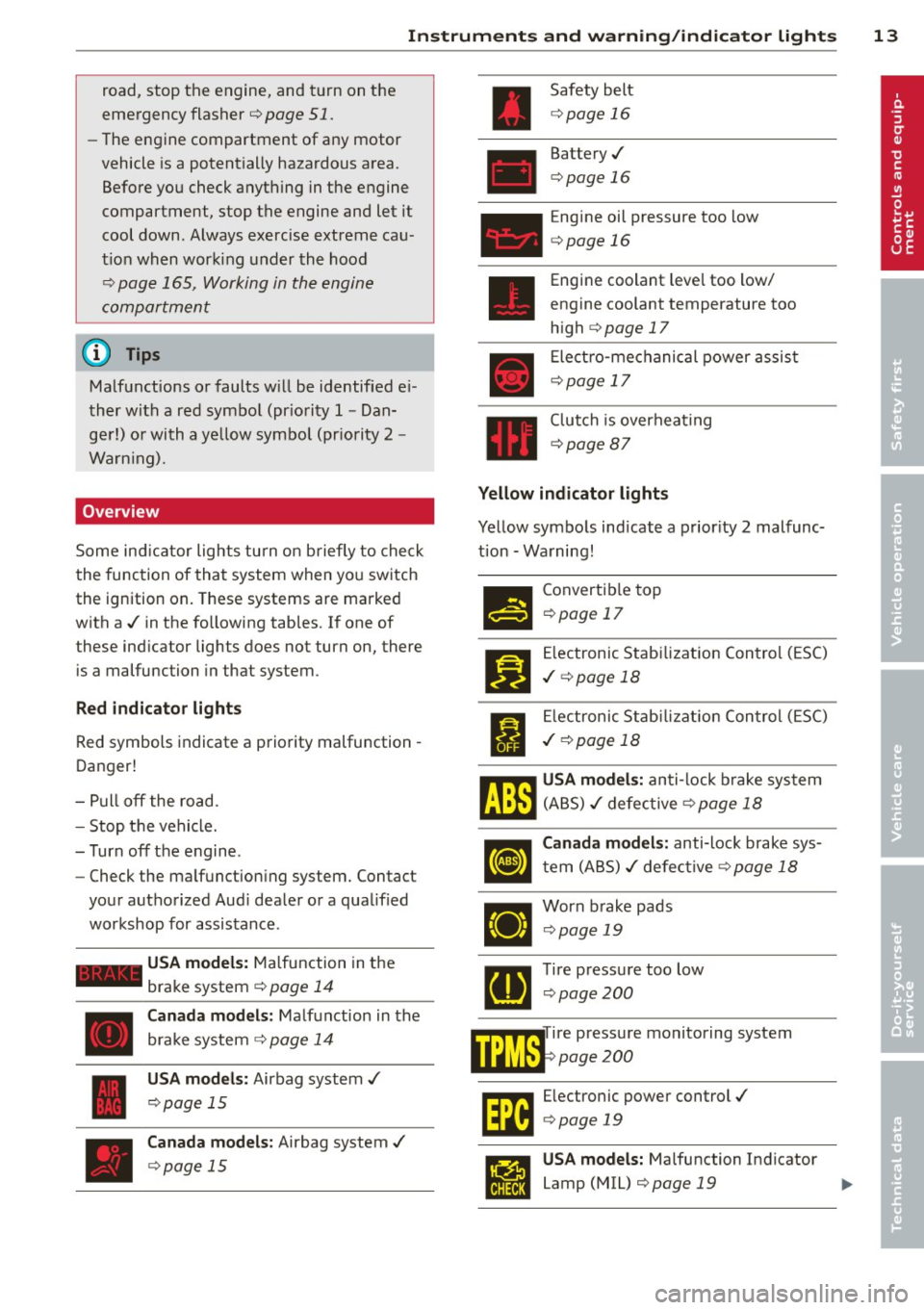
Instrument s and warnin g/indic ator ligh ts 13
road, stop the engine, and turn on the
emergency flasher¢
page 51.
-The engine com partment of any motor
vehicle is a potentially hazardous area.
Before you check anything in the engine
compartment, stop the engine and let it
cool down. Always exercise extreme cau
t ion when wor king under the hood
¢ page 165, Working in the engine
compartment
(D Tips
Ma lfunctions or faults w ill be identified e i
ther with a red symbo l (pr iority 1 -Dan
ge r!) o r with a ye llow symbol (pr iority 2 -
Warn ing).
Overview
Some ind icator lights turn on briefly to check
the function of that system when yo u switch
the ignition on. These systems are marked
with a./ in the following tab les. If one of
these ind icator lights does not turn on, there
is a malfunction in that system.
R ed indicator lights
Red symbols indicate a priority malfu nction -
Danger!
- P ull off the road.
- Stop t he vehicle.
- T urn off the engine .
- Check the ma lfunction ing system. Contact
you r authorized Aud i dealer o r a qualified
workshop for assistance .
-USA model s: Ma lfunction in the
brake system ¢
page 14
Canada model s: Ma lf u nction in the
brake system ¢
page 14
USA models: Airbag system ./
¢page 15
Canada model s: Airbag system ./
¢page 15
Safety belt
¢page 16
Battery./
¢page 16
Engine oil pressure too low
¢ page 16
Engine coolant level too low/
engine coolant temperature too
h igh
¢ page 17
Electro-mechanical power assis t
¢page 17
Clutch is overhea ting
¢page 87
Yellow indicator lights
Yellow symbo ls indicate a prior ity 2 malfunc
t ion -Wa rning!
•
I
Convertib le top
¢ page 17
Electronic Stab ilizat ion Con tro l (ESC)
./ ¢page 18
Electronic St abiliz at ion Con tro l (ES C)
./ ¢page 18
~ USA models : anti- lock b rake system
liJ.:tl (A BS) ./ defec tive ¢ page 18
•
Canada models : anti-lock brake sys
t em (ABS) ./ defect ive ¢
page 18
Worn b rake pads
¢ page 19
Tire pressure too low
¢ page 200
mfflT ire pressure monitoring system
WiU.t:.F page 200
~ Electronic power control./
1.1&:J ¢ page 19
USA models: Malfunction Indicator
Lamp (MIL)
¢page 19
Page 16 of 244
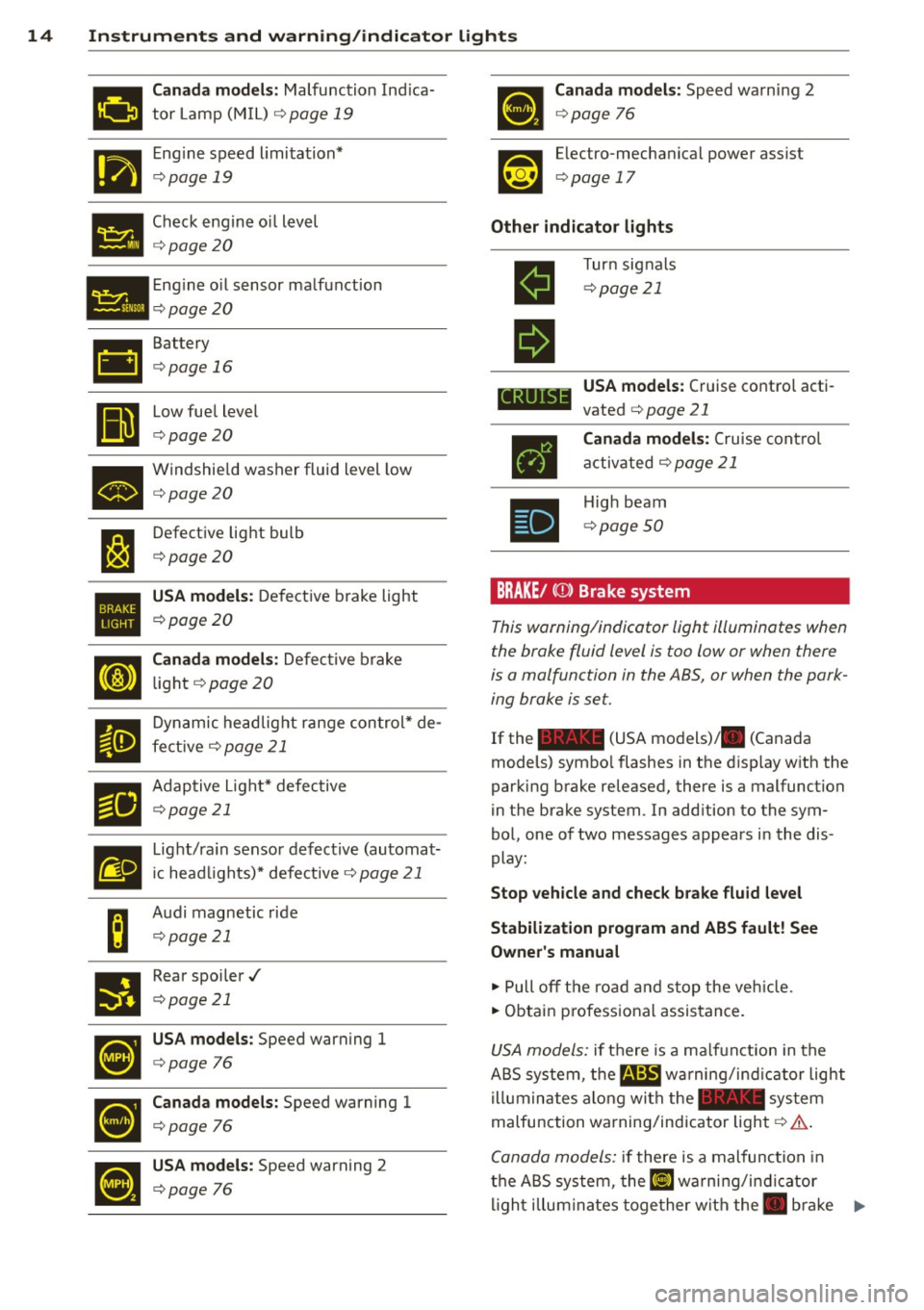
14 Instruments and warning/indicator lights
111'!!1 Canada models: Malfunction Indica
mil tor Lamp (M IL) ¢ page 19
I'm Engine speed limitation*
1111111 ¢ page 19
• Check engine o
il level ¢ page20
• Engine
oil sensor malfunction ¢ page20
•
II
Battery
¢page 16
Low fuel level
¢page20
• Windshie
ld washer fluid level low ¢ page20
l:J
Defective light bulb
¢page20
•
USA models : Defective brake light
¢page 20
Cl
Canada models: Defective brake
light
¢ page 20
II
Dynamic headlight range control* de-
fective ¢
page 21
El
Adaptive L ight* defective
¢page 21
m
Light/rain sensor defective (automat-
ic head lights)* defective ¢
page 21
B
Audi magnetic ride
¢page 21
•
Rear spoiler../
¢page 21
~
USA models : Speed warning 1
¢page 76
•
Canada models: Speed warning 1
¢page 76
•
USA models : Speed warning 2
¢page 76
Canada models: Speed warning 2
¢page 76
Electro-mechanical power assist
¢ page 17
Other indicator lights
II
II
CRUIS
•
Turn signals
¢page 21
USA models: Cruise control acti
vated ¢
page 21
Canada models: Cruise control
activated ¢
page 21
High beam
¢page 50
BRAKE/ (CD) Brake system
This warning/indicator light illuminates when
the brake fluid level is too low or when there
is a malfunction in the ABS, or when the park
ing brake is set.
If the - (USA models)/ . (Canada
models) symbo l flashes in the disp lay with the
parking brake released, there is a malfunction
in the brake system. In addition to the sym
bol, one of two messages appears in the dis
play:
Stop vehicle and check brake fluid level
Stabilization program and ABS fault! See
Owner's manual
.,. Pull off the road and stop the vehicle.
.,. Obtain p rofessional assistance.
USA models: if there is a ma lfunction in the
ABS system, the
m;B warning/ind icator light
illuminates along with the - system
malfunction warning/indicator light¢
A.
Canada models: if there is a malfunction in
the ABS system, the~ warning/i ndicator
lig ht i llum inates together with the. bra ke ..,_
Page 17 of 244
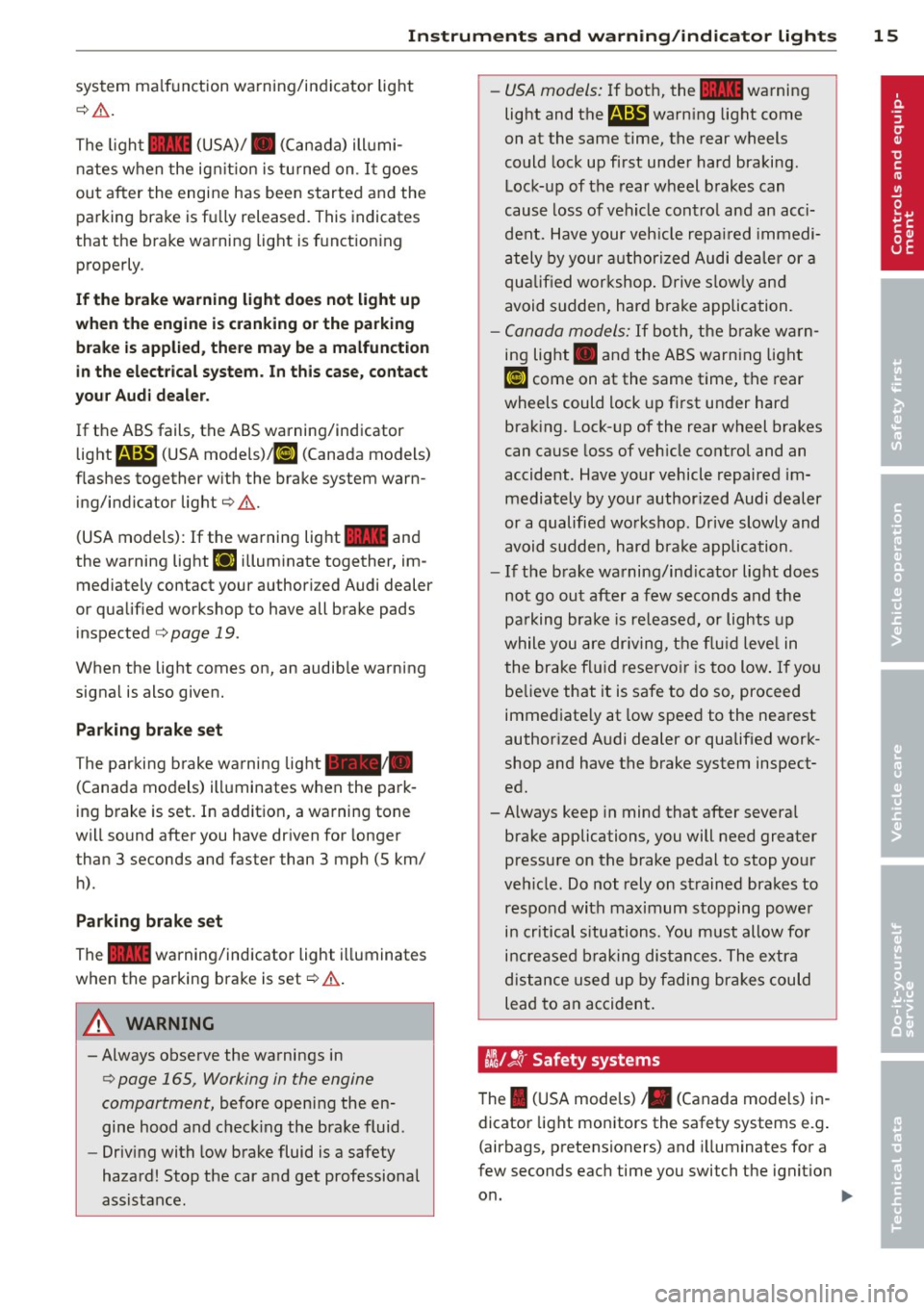
Instrument s and warnin g/indic ator ligh ts 15
system ma lfunction warning/indicator light
c> ,&. .
The ligh t 1111 (USA)/ . (Canada) illumi
nates when the ignit ion is tu rned on. I t goes
out after the engine has been started and the
parking brake is fully released. This indicates
that the brake warning lig ht is funct ion ing
properly.
If the brake warn ing light doe s not light up
w hen the engin e is cr anking o r the p arking
br ak e is applied, th ere m ay be a malfun ction
in th e electrical syste m. In thi s cas e, conta ct
y ou r A udi dealer .
If the ABS fails, the ABS warning/indicator
light
E (USA mode ls)! EIJ (Canada models)
f lashes together with the brake system warn
ing/indicator light
c> ,&. .
(USA models): If the warning light 1111 and
the warning light
EiJ illum inate together, im
mediately contact your author ized Audi dealer
or qualified workshop to have all brake pads
inspected
c> page 19.
When the light comes on, an audible warning
signa l is also given.
Parking brake set
The parking brake warning light_ /_
(Canada models) illuminates when the park
ing brake is set. In addition, a warning tone
will sound after you have driven for longer
than 3 seconds and faster than 3 mph (5 km/
h).
Park ing brak e set
The 1111 warning/indicator light illuminates
when the parking brake is set
c> &..
A WARNING
-Always observe the warnings in
c> page 165, Working in the engine
compartment, before opening the en
gine hood and check ing the bra ke fluid.
- Driv ing with low brake fluid is a safety
hazard! Stop the car and get professional
assistance. -
USA models: If both, the
1111 warning
light and the
E warn ing light come
on at the same time, the rear wheels
could lock up first under hard braking.
Lock-up of the rear wheel brakes can
cause loss of vehicle contro l and an acci
dent. Have your veh icle repa ired immedi
ately by your authorized Audi dealer or a
qualified workshop . Drive s low ly and
avoid sudden, hard brake application.
- Canada models:
If both, the b rake warn
ing light . and the ABS warning light
EiJ come on at the same time, the rear
wheels could lock up f irst under hard
brak ing. Lock-up of the rear wheel brakes
can cause loss of veh icle control and an
accident. Have your vehicle repaired im
mediately by your author ized Audi dealer
or a qualified wo rkshop. Drive slowly and
avoid sudden, hard brake application.
- If the b rake warning/ind icator light does
not go out after a few seconds and the
pa rking brake is re leased, or lights up
while you are dr iving, the flu id leve l in
the brake fl uid reservo ir is too low . If you
believe that it is safe to do so, proceed
immediate ly at low speed to the nea rest
author ized Audi dealer or qualif ied work
shop and have the brake system inspect
ed.
-Always keep in mind that after severa l
brake applications, you will need greater
pressure on the brake pedal to stop your
veh icle. Do not rely on strained brakes to
respond with maximum stopping powe r
i n critical s ituations. You must allow for
increased b raking dis tances. The extra
distance used up by fading bra kes could
lead to an accident.
tli1 !.!r Safety systems
The I ( U SA models) . (Canada mode ls) in
dicator light monitors the safety systems e.g.
(airbags, pretensioners) and i lluminates for a
few seconds each time you switch the ignitio n
o n.
Page 20 of 244
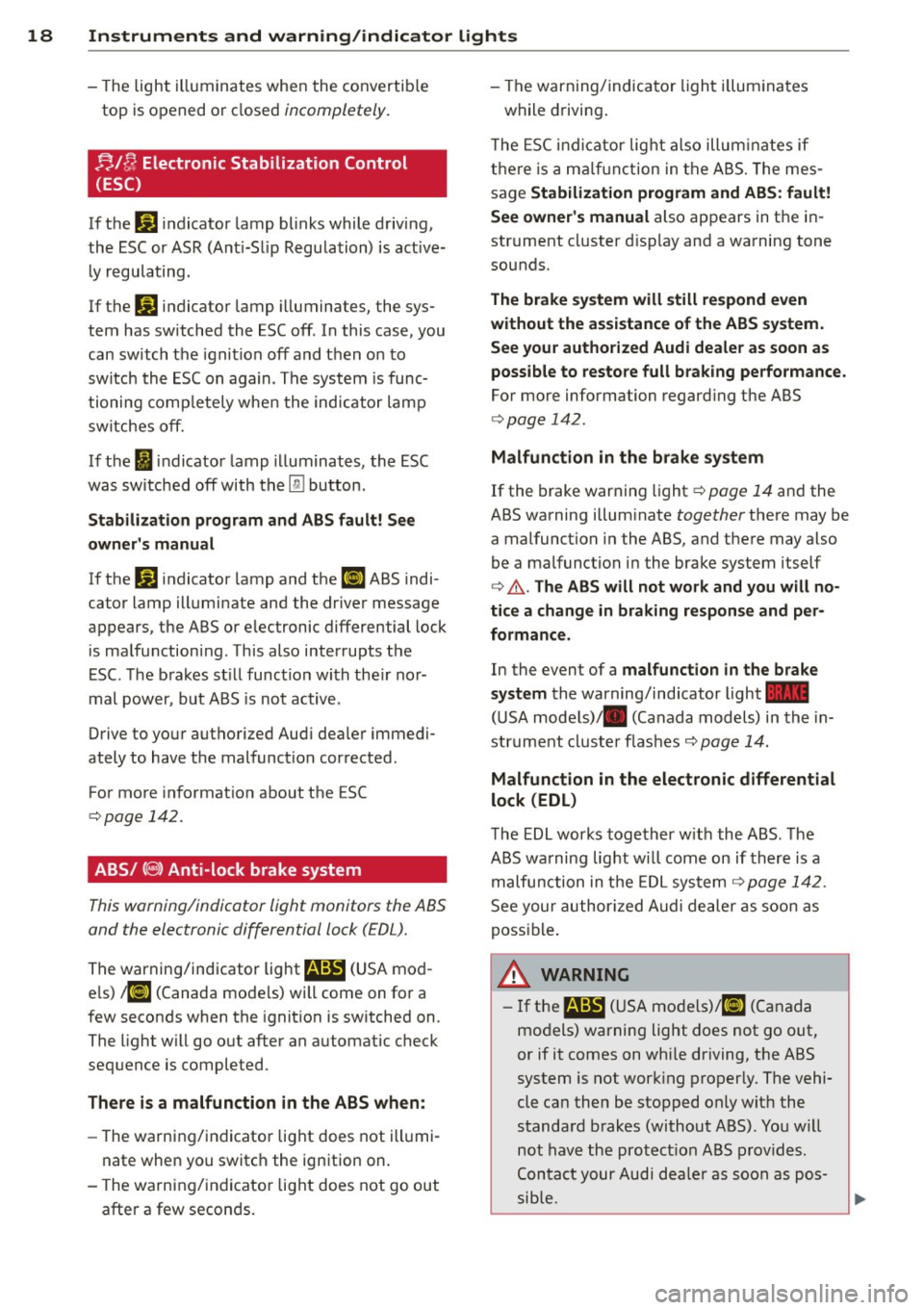
18 Instrum ent s and w arn ing /indic ato r light s
-The light illuminates when the convertib le
top is opened or closed incompletely.
nlfJ Electronic Stabilization Control
(ESC)
If the Ji) indicator lamp blinks while driving,
the ESC or ASR (Ant i-Slip Regulation) is active
l y regulating .
If the
Ji) indicator lamp illuminates, the sys
tem has switched the ESC off. In this case, you
can switch the ignition
off and then on to
switch the ESC on again . The system is func
tioning comp letely whe n the indicator lamp
switches off.
If the
i indicator lamp illuminates, the ESC
was switched
off with the [ru button .
Stabiliz ation prog ram and ABS fault! See
own er's manu al
If the J;.J indicator lamp and the El ABS indi
cator lamp illuminate and the dr iver message
appears, the ABS or e lec tronic differential lock
is ma lfunctioning . This also interrupts the
ESC. The brakes st ill function with the ir nor
mal power, but ABS is not active .
Drive to your authorized Aud i dea ler immedi
ately to have the malfunction corrected .
For more information about the ESC
c:::;,page 142.
ABS/ (8 ) Anti-lock brake system
This warning/indicator light monitors the ABS
and the electronic differential lock (EDL).
The warning/indicator light
E (USA mod
e ls)
;riJ (Canada mode ls) will come on for a
few seconds when the ignition is sw itched on .
The light will go out after an automatic check
sequence is comple ted.
The re i s a malfuncti on in the ABS when :
-The warning/indicator light does not ill umi
nate when you switch the ign ition on.
- The warning/indicator light does not go out
after a few seconds . - The warning/
indica tor light i lluminates
while driving .
T he ESC indi cator lig ht also illum inates if
there is a ma lf u nction in the ABS. The mes
sage
Stabiliz ation program and ABS : fa ult!
Se e owne r's ma nual
also appears in the in
strument cluster d isp lay and a warning tone
sounds.
The brake system will still re spond e ven
without the a ssistan ce of the ABS system.
See your authorized Audi de aler as soon as
possible to re store full b raking perfo rmance.
For more info rmation regard ing the ABS
c:::;, page 142.
Malfunction in the br ake sy stem
If the brake warning light c:::;, page 14 and the
ABS warning illuminate together there may be
a malfunction in the ABS, and there may also
be a malfunction in the brake system itself
c:::;,
&. . The AB S will not wo rk and you will no
ti ce a change in braking re spon se and p er
formanc e.
In the even t of a mal func tion in the brake
sy stem
the warning/ind icator light 1111
( U SA models)/ . (Canada models) in the in
strument cluster flashes c:::;, page 14.
Malfunction in the electronic differential
lock (EDL )
The EDL works together w ith the ABS . The
ABS warning light wi ll come on if there is a
malfunction in the EDL sys tem
c:::;, page 142 .
See your author ized Audi dealer as soon as
possible .
A WARNING ,-=
-If the E (USA mode ls)/ Ei] (Canada
models) warning light does not go out,
or if it comes on whi le driving, the ABS
system is not work ing properly. The vehi·
cle ca n then be stopped only wit h the
standard brakes (without ABS) . You w ill
not have the protect ion ABS prov ides .
Contact your Audi dea le r as soon as pos
sib le.
-
.__ _______________ _J ~
Page 21 of 244
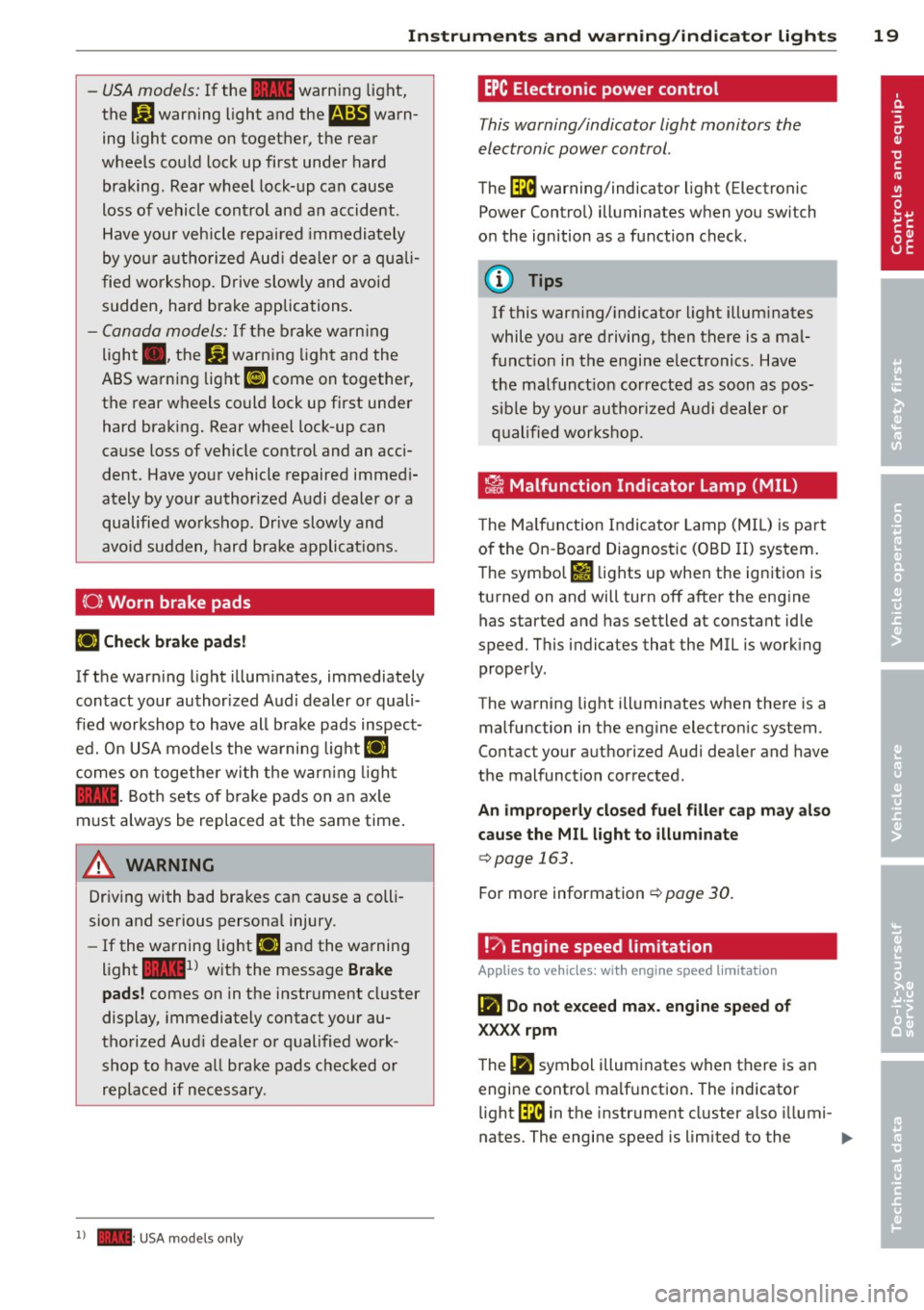
Instrument s and warnin g/indic ator ligh ts 19
-USA models: If the la warning light,
the
G1 warning light and the m:IJ warn
ing light come on together, t he rear
wheels could lock up first under hard
braking. Rear wheel lock-up can cause
loss of vehicle control and an accident .
Have your vehicle repai red immediately
by you r autho rized Aud i dea ler or a qua li
fied workshop. Drive slowly and avoid
sudden, hard brake applications .
-Canada models: If the brake warn ing
light ., the
&J warn ing light and the
ABS warning light
[IJ come on together,
the rear wheels could lock up first under
hard braking. Rear wheel lock-up can
cause loss of vehicle control and an acci
dent . Have you r vehicle repaired immed i
ately by your authorized Audi dealer or a
qualified wo rkshop . Dr ive slowly and
avo id sudden, hard brake applicat ions.
( 0) Worn brake pads
riJ Che ck brake pad s!
If the warn ing light illum inates, immediately
contact your authorized A udi dealer or quali
f ied workshop to have all brake pads inspect
ed. O n USA models the wa rning lig ht
riJ
comes on togethe r wi th the warn ing light
la . Both sets of b ra ke pads on an axle
must always be replaced at the same time .
A WARNING
Driving with bad brakes can cause a colli
sion and serious personal injury.
- If the warning light riJ and the warning
light
lai1 ) w it h the message Brake
pads !
comes on in the instr ument cluster
display, immediately contact your au
tho rized Aud i dea le r or qualified work
shop to have a ll brake pads checked or
replaced if necessary .
1) - : USA mod els on ly
-
EPC Electronic pow er control
This warning/indicator light monitors the
electronic power control.
The ~ warning/indicator light (Electronic
Power Control) illuminates when you switch
on the ignition as a function check .
@ Tips
If this warning/ indicato r light illum inates
while you are driving, then there is a mal
funct ion in the engine electronics . Have
the malfunct ion corrected as soon as pos
sible by your authori zed A udi dealer or
q ualified works hop .
~ Malfunction Indicator lamp (MIL )
The Ma lfun ction Indicator Lamp ( MIL) is par t
of the On -Board Diagnostic (OBD II) system.
The symbo l
fl lights up when the ignition is
turned on and will turn off after the eng ine
has started and has settled at constant idle
speed . This indicates that the MIL is work ing
proper ly.
The warning light illuminates when there is a
malfu nction in the eng ine electron ic system .
Contact your a uthorized Audi dea ler and have
the malfunction corrected.
An improperly closed fuel filler cap may also
cause the MIL l ight to illum inate
c::> page 163.
For more information c::> page 30 .
!?) Engine speed limitation
App lies to vehicles : wi th engine speed limitatio n
(m Do not e xceed ma x. engine speed of
XXXX rpm
The (Ill symbol illuminates when there is an
engine contro l ma lf u nction . The indicator
li ght ~ in the instrument cl uster a lso illumi-
nates. The engine speed is limited to the .,.
Page 91 of 244

Homelink
Universal remote
control
General information
The HomeLink universal remote control can
be programmed with hand-held transmitters
from existing equipment.
You must first program the Homelink trans
mitter before you can use the system
~ page 89, Programming the HomeLink
transmitter.
In order to program the Homelink transmit
ter for devices utilizing rolling code, a second
person on a ladder who can safely reach the
garage door opener motor is recommended.
It is also necessary to locate the "learn" but
ton on your garage door opener motor . Refer
to the operating instructions for the opener, as the location and color of this button may
vary by manufacturer .
You can still use the origina l remote control
for the device at any time.
A WARNING
-
- Never use the Homelink transmitter
with any garage door opener that does
have not the safety stop and reverse fea
ture as requ ired by federal safety stand
ards. This includes any garage door open
er model manufactured before April 1,
1982.
- A garage door opener which cannot de
tect an object, signaling the door to stop
and reverse does not meet current feder
al safety standards. Using a garage door
opener without these features increases
risk of serious injury or death.
- For safety reasons never release the
parking brake or start the engine while
anyone is standing in front of the vehicle.
- A garage door or an estate gate may
sometimes be set in motion when the Homelink remote control is being pro
grammed. If the device is repeatedly ac-
Homelink 89
tivated, this can overstrain motor and
damage its electrical components -an
overheated motor is a fire hazard!
- To avoid possible injuries or property
damage, please always make absolutely
certain that no persons or objects are lo
cated in the range of motion of any
equipment being operated.
(!) Tips
- If you would like more information on
Homelink, where to purchase the Home
Link compat ible products, or would like
to purchase the Homelink Home Light
ing Package, please call toll-free:
1-800-355-3515.
- For Declaration of Compliance to United
States FCC and Industry Canada regu la
tions
~page 229.
Programming the Homelink transmitter
The transmitter is programmed in two phas
es. For rolling code transmitters, a third
phase is also necessary.
Fig. 98 Overhead co nsole: Homelink keypad
Fig. 99 Fro nt bumper, d river side: locatio n of tra nsm it-
ter unit
IJ-
Page 100 of 244

98 Driving Safely
• Distribute the load evenly in the luggage
compartment.
• Always place and properly secure heavy
items in the luggage compartment as far
forward as possible.
A WARNING
Improperly stored luggage or other items
can fly through the vehicle causing serious
personal injury in the event of hard brak
ing or an accident. To help reduce the risk
of serious personal injury:
- Always put objects, for example, luggage
or other heavy items in the luggage com
partment.
- Always secure objects in the luggage
compartment using the tie-down eyelets
and suitable straps.
A WARNING
Heavy loads will influence the way your ve
hicle handles. To help reduce the risk of a
loss of control leading to serious personal
injury:
-Always keep in mind when transporting
heavy objects, that a change in the cen
ter of gravity can also cause changes in
vehicle handling:
- Always distribute the load as evenly as
possible.
- Place heavy objects as far forward in
the luggage compartment as possible.
- Never exceed the Gross Axle Weight Rat
ing or the Gross Vehicle Weight Rating
specified on the safety compliance stick
er on the left door jamb. Exceeding per
missible weight standards can cause the
vehicle to slide and handle differently.
- Please observe information on safe driv
ing
!:? page 92 .
A WARNING
To help prevent poisonous exhaust gas
from being drawn into the vehicle, always
keep the rear lid closed while driving.
- Never transport objects larger than
-
those fitting completely into the luggage area because the rear lid cannot be fully
closed.
- If you absolutely must drive with the rear
lid open, observe the following notes to
reduce the risk of poisoning:
- Close all windows,
- Close the convertible top,
- Open all air outlets in the instrument
panel,
- Switch off the air recirculation,
- Set the fresh air fan to the highest
speed.
A WARNING
-Always make sure that the doors, all win-
dows, the convertible top and the rear lid
are securely closed and locked to reduce
the risk of injury when the vehicle is not
being used.
- After closing the rear lid, always make
sure that it is properly closed and locked.
- Never leave your vehicle unattended es pecially with the rear lid left open . A
child could crawl into the vehicle through
the luggage compartment and close the
rear lid becoming trapped and unable to
get out. Being trapped in a vehicle can
lead to serious personal injury.
- Never let children play in or around the
vehicle.
- Never let passengers ride in the luggage
compartment. Vehicle occupants must
always be properly restrained in one of
the vehicle's seating positions.
@ Tips
- Air circulation helps to reduce window
fogging. Stale air escapes to the outside
through vents in the trim panel , on the
left side of the luggage compartment.
Be sure to keep these slots free and
open.
- The tire pressure must correspond to the
load. The tire pressure is shown on the
tire pressure label. The tire pressure la bel is located on the driver's side B-pillar .
The tire pressure label lists the ..,
Page 104 of 244
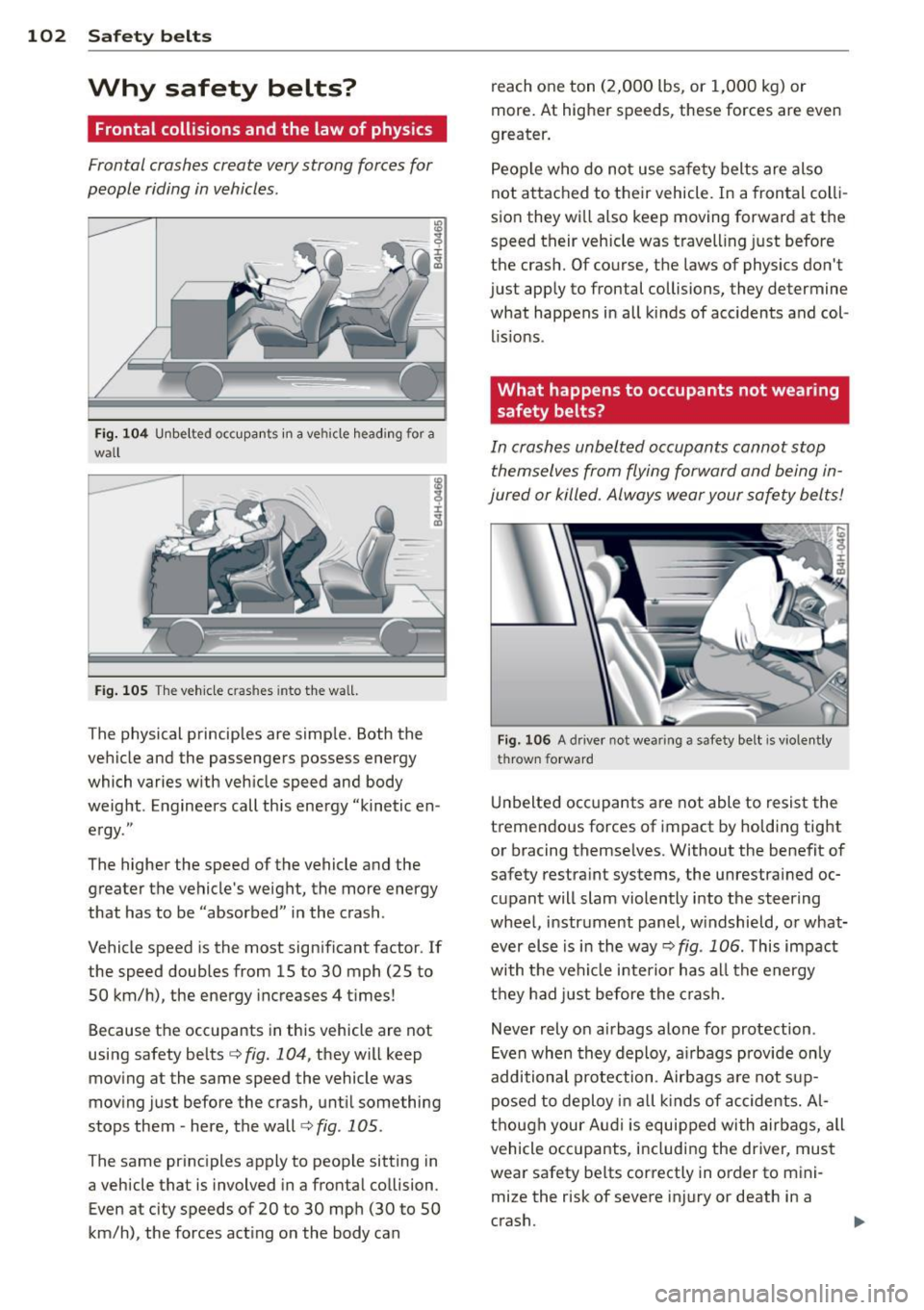
102 Safet y belt s
Why safety belts?
Frontal collisions and the law of physics
Frontal crashes create very strong forces for
people riding in vehicles .
Fig. 10 4 Unbe lted occupa nts in a vehicle heading for a
wall
Fig . 105 The ve hicle c ras hes into t he wa ll.
The physical principles are simp le. Both the
vehicle and the passengers possess energy
which varies w ith veh icle speed and body
weight . Engineers call th is energy ''kinetic en
ergy ."
The higher the speed of the vehicle and the
greater the vehicle's weight, the more energy
that has to be "absorbed" in the crash .
Vehicle speed is the most significant factor . If
the speed doub les from 15 to 30 mph (25 to
50 km/h) , the energy increases 4 t imes!
Because the occupants in this vehicle are not
using safety belts ¢
fig. 104, they will keep
mov ing at the same speed the vehicle was
mov ing just before the crash, unti l something
stops them -here, the wall
¢ fig . 105 .
The same pr inc iples apply to people sitting in
a vehicle that is involved in a frontal collision .
Even at city speeds of 20 to 30 mph (30 to 50
km/h), the forces act ing on the body can reach one ton (2,000 lbs, or 1,000 kg) or
more. At h
igher speeds, these forces are even
greater.
People who do not use safety belts are also
not attached to their vehicle. In a frontal colli
sion they wi ll also keep moving forward at t he
speed their vehicle was travell ing just before
the crash. Of course, the laws of physics don't
just app ly to frontal collisions, they determine
what happens in all kinds of acc idents and col
lis ions .
What happens to occupants not wearing
safety belts?
In crashes unbelted occupants cannot stop
themselves from flying forward and being in
jured or killed . Always wear your safe ty belts!
Fig . 106 A dr iver not wea ring a safety belt is vio le n tl y
t hrown forward
Unbelted occ upants a re not able to resist the
tremendous forces of impact by hold ing tight
or bracing themse lves. Without the benefit of
safety restra int systems, the unrestrained oc
cupant will slam violently into the steering
wheel, instr ument panel, w indshield, or what
ever else is i n the way ¢ fig. 106. This impact
with the veh icle inte rior has all the energy
they had j ust before the c rash.
Never rely on airbags alone for protection .
Even when they deploy, a irbags provide only
additional protection . Airbags a re not sup
posed to deploy in all k inds of accidents. A l
t h ough your Aud i is equipped wi th airbags, all
vehicle occupants, including the driver, must
wear safety be lts cor rectly in order to m ini
mize the risk of severe injury or death in a
crash .
Page 105 of 244
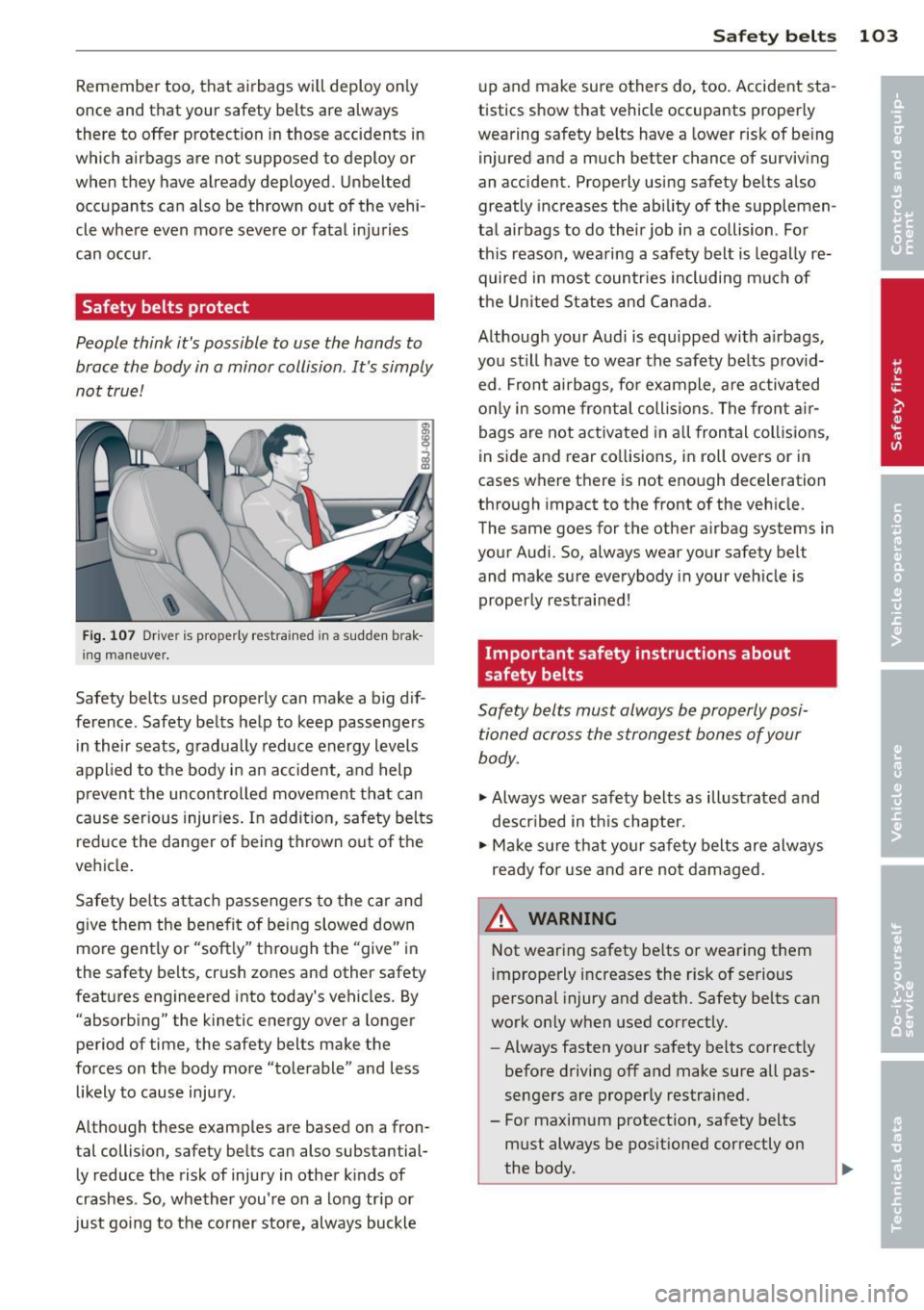
Remember too, that airbags will deploy only
once and that your safety belts are always
there to
offer protection in those accidents in
which airbags are not supposed to deploy or
when they have already deployed . Unbelted
occupants can also be thrown out of the vehi
cle where
even more severe or fatal injuries
can occur .
Safety belts protect
People think it's possible to use the hands to
brace the body in a minor collision . It's simply
not true!
Fig . 107 Driver is properly restrained in a sudden b rak
i ng maneuve r.
Safety belts used properly can make a big dif
ference . Safety belts help to keep passengers
in their seats, gradually reduce energy levels
applied to the body in an accident, and help
prevent the uncontrolled movement that can
cause serious injuries. In addition, safety belts
reduce the danger of being thrown out of the
vehicle.
Safety belts attach passengers to the car and
give them the benefit of being slowed down
more gently or "softly" through the "give" in
the safety belts, crush zones and other safety
features engineered into today's vehicles . By
"absorbing" the kinetic energy
over a longer
period of time, the safety belts make the
forces on the body more "tolerable " and less
likely to cause injury.
Although these examples are based on a fron tal collision, safety belts can also substantial
ly reduce the risk of injury in other kinds of
crashes. So, whether you're on a long tr ip or
just going to the corner store, always buckle
Safety belts 103
up and make sure others do, too. Accident sta
tistics show that vehicle occupants properly
wearing safety belts have a lower risk of be ing
injured and a much better chance of surviving
an accident. Properly using safety belts also
greatly increases the ability of the supplemen
tal airbags to do the ir job in a collision . For
th is reason, wearing a safety belt is legally re
quired in mos t countries including much of
the United States and Canada.
Although your Audi is equipped with a irbags,
you still have to wear the safety belts provid
ed . Front airbags, for example, are activated
only in some frontal collisions. The front air
bags are not activated in all frontal coll isions,
in side and rear collisions, in roll overs or in
cases where there is not enough deceleration
through impact to the front of the vehicle.
The same goes for the other airbag systems in
your Audi . So, always wear your safety belt
and make sure everybody in your vehicle is
properly restrained!
Important safety instructions about
safety belts
Safety belts must always be properly posi
tioned across the strongest bones of your
body .
"' Always wear safety belts as illustrated and
described in th is chapter.
"'Make sure that your safety belts are always
ready for use and are not damaged.
A WARNING ~
Not wearing safety belts or wearing them
improperly increases the risk of serious
personal injury and death. Safety belts can
work only when used correctly.
- Always fasten your safety belts correctly
before driving
off and make sure all pas
sengers are properly restrained.
- For maximum protection, safety belts must always be positioned correctly on
the body .
Page 115 of 244
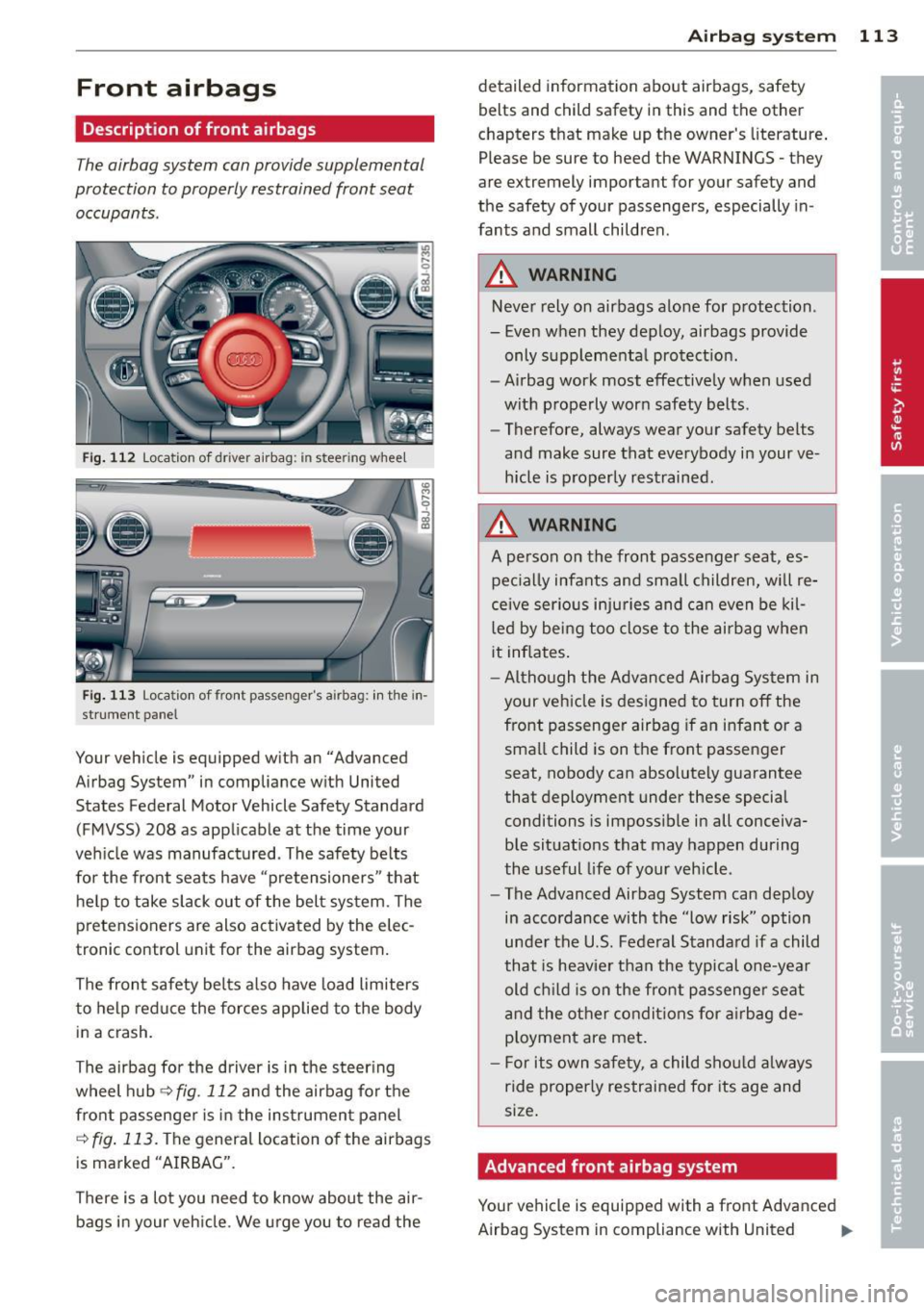
Front airbags
Description of front airbags
The airbag system can provide supplemental
protection to properly restrained front seat
occupants .
Fig. 112 Location of dri ver airbag: in steering whee l
Fig. 113 Location of front passe nger's ai rb ag : in the in
strument panel
Your vehicle is equipped with an "Advanced
Airbag System" in compliance with United
States Federal Motor Vehicle Safety Standard
(FMVSS) 208 as applicable at the time your
vehicle was manufactured . The safety belts
for the front seats have "pretensioners" that
help to take slack out of the belt system. The
pretensioners are also activated by the elec
tronic control unit for the airbag system.
The front safety belts also have load limiters
to help reduce the forces applied to the body
in a crash .
The airbag for the driver is in the steering
wheel hub¢
fig. 112 and the airbag for the
front passenger is in the instrument panel
¢fig. 113. The general location of the airbags
is marked "AIRBAG".
There is a lot you need to know about the air
bags in your vehicle. We urge you to read the
Airbag system 113
detailed information about airbags, safety
belts and child safety in this and the other
chapters that make up the owner's literature .
Please be sure to heed the WARNINGS - they
are extremely important for your safety and
the safety of your passengers, especially in
fants and small children.
A WARNING ,.;;
Never rely on airbags alone for protection .
- Even when they deploy, airbags provide
only supplementa l protection.
- Airbag work most effectively when used
with properly worn safety belts.
- Therefore, always wear your safety belts
and make sure that everybody in your ve
hicle is properly restrained.
A WARNING
A person on the front passenger seat, es
pecially infants and small children, will re
ceive serious injuries and can even be kil
led by being too close to the airbag when
it inflates .
- Although the Advanced Airbag System in
your vehicle is designed to turn off the
front passenger airbag if an infant or a
small child is on the front passenger
seat, nobody can absolutely guarantee
that deployment under these special
conditions is impossible in all conceiva
ble situations that may happen during
the useful life of your vehicle .
- The Advanced Airbag System can deploy
in accordance with the "low risk" option
under the U.S. Federal Standard if a child
that is heavier than the typical one-year
old child is on the front passenger seat
and the other condit ions for airbag de
ployment are met.
- For its own safety, a child should always
ride properly restrained for its age and
size.
Advanced front airbag system
-
Your vehicle is equipped with a front Advanced
Airbag System in compliance with United
Ill>